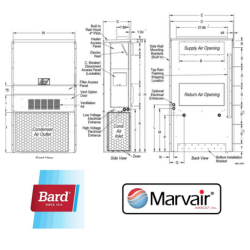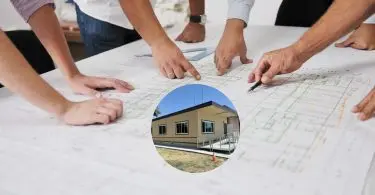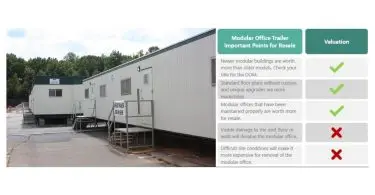What are the best practices for maintaining a wall-mounted HVAC system in a modular building or Portable Classroom?
This guide offers 15 tips and best practices for maintaining wall-mounted HVAC systems in modular buildings and portable classrooms to optimize performance, prolong HVAC equipment life, and create comfortable environments for building occupants. Be sure to watch the Training Video under tip #4!
- Regular Filter Cleaning/Replacement: Clean or replace the air filters regularly to maintain air quality and efficiency. A clogged filter can strain the system and reduce its effectiveness.
- Routine Inspections: Conduct routine inspections of the entire HVAC system and be sure that the area surrounding the HVAC unit is free and clear of any obstacles, such as trees and vines. This makes access to the unit easier and safer and allows for proper ventilation.
- Check Refrigerant Levels: Ensure the refrigerant level is adequate. Incorrect levels can lead to decreased efficiency and potential damage to the compressor.
- Maintain the Condenser and Evaporator Coils: Keep the condenser and evaporator coils clean. Dirt and debris can impede airflow and reduce the system’s ability to absorb and expel heat.
Training Video: Here is an excellent video about Condensor Coil Cleaning in a wall-mount HVAC system manufactured by Bard. - Ensure Proper Drainage: Check the condensate drain for clogs. A clogged drain can cause water damage and increase humidity levels.
- Inspect and Seal the Ductwork: Regularly inspect the ductwork for leaks or damage. Properly sealed and insulated ducts improve efficiency and performance. Also, keep the ductwork clean and look for any signs of mold. Call your HVAC contractor for advice and immediate remediation if you find mold.
- Monitor Thermostat Operation: Ensure the thermostat works correctly and accurately reflects the desired temperature settings.
- Clear Debris Around Outdoor Units: Keep the area around outdoor units clear of debris, leaves, and dirt to ensure unobstructed airflow.
- Check Electrical Connections: Inspect for wear, corrosion, or damage signs. Ensure all connections are secure.
- Lubricate Moving Parts: Lubricate motors and bearings to reduce friction, which can prolong the life of these components.
- Address Noise and Vibration Issues: Investigate any unusual noises or vibrations, as these can be early signs of mechanical problems.
- Professional Servicing: Have the system professionally serviced at least once a year. Technicians can perform more complex checks and repairs.
- Upgrade Insulation When Needed: Ensure proper insulation in the areas around the HVAC system to improve efficiency.
- Evaluate System Age and Performance: Regularly assess your HVAC system’s age and overall performance. Older systems may be less efficient and more prone to breakdowns.
- Training and Awareness: Educate staff or occupants about the proper use and basic maintenance of the HVAC system to prevent misuse and spot potential issues early.

By implementing the 15 tips outlined in this guide, facility managers in diverse sectors, from corporate offices to educational institutions, can ensure their modular environments remain comfortable, energy-efficient, and cost-effective. Regular upkeep and informed practices are the pillars of sustaining high-performance HVAC systems. We encourage you to integrate these best practices into your maintenance routines, reinforcing your commitment to excellence in facility management. For more insights and expert advice on modular building maintenance, continue exploring our resources at iModular.com. Let’s work together to create healthier, more sustainable modular spaces for everyone.




